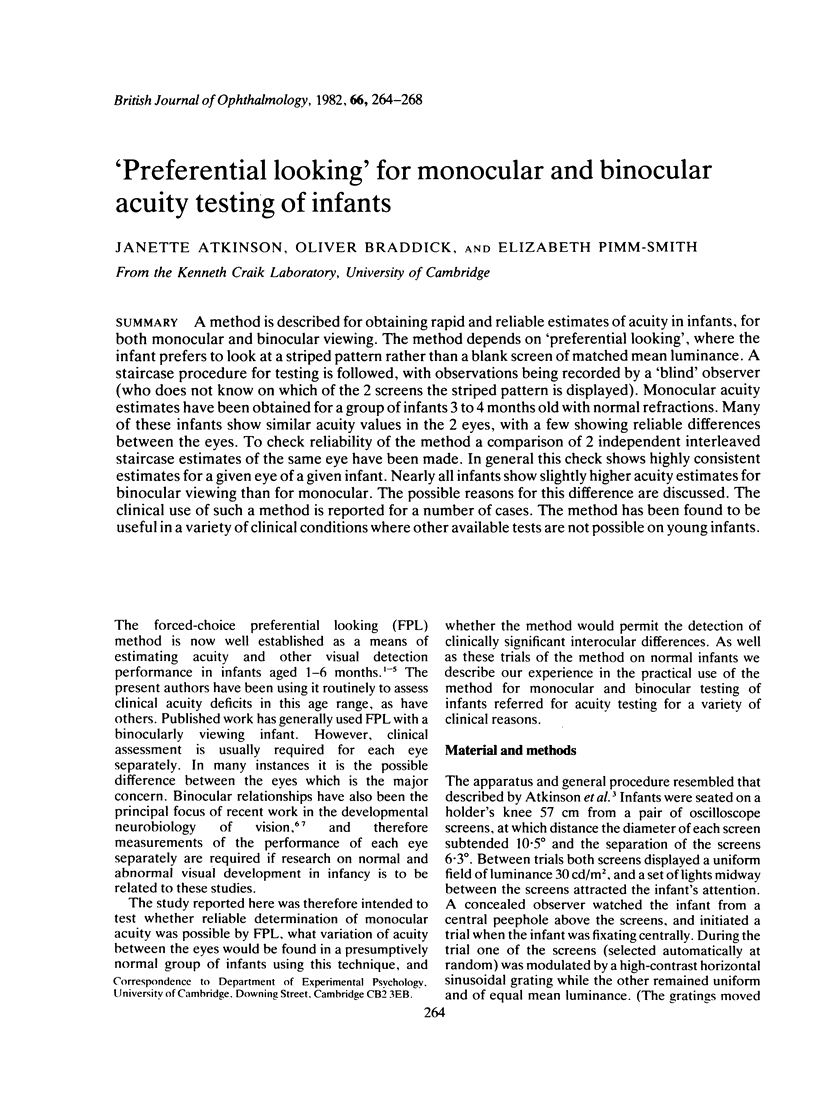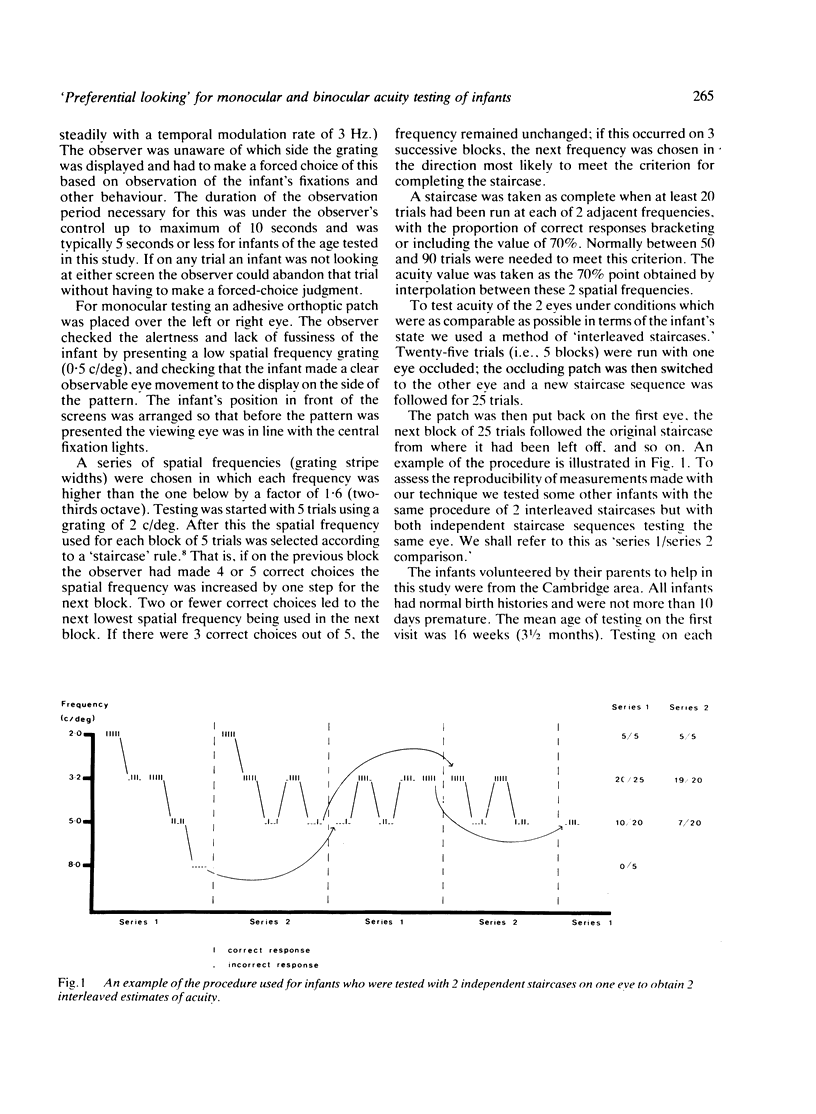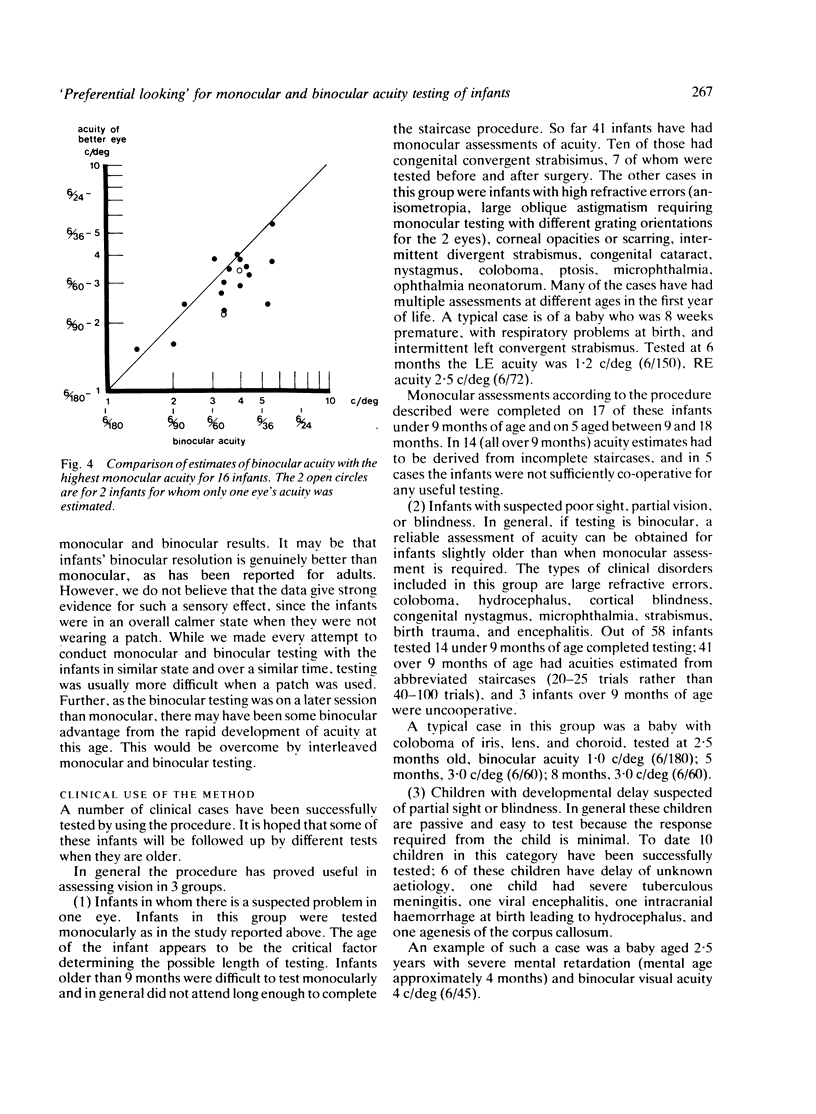Abstract
A method is described for obtaining rapid and reliable estimates of acuity in infants, for both monocular and binocular viewing. The method depends on 'preferential looking', where the infant prefers to look at a striped pattern rather than a blank screen of matched mean luminance. A staircase procedure for testing is followed, with observations being recorded by a 'blind' observer (who does not know on which of the 2 screens the striped pattern is displayed). Monocular acuity estimates have been obtained for a group of infants 3 to 4 months old with normal refractions. Many of these infants show similar acuity values in the 2 eyes, with a few showing reliable differences between the eyes. To check reliability of the method a comparison of 2 independent interleaved staircase estimates of the same eye have been made. In general this check shows highly consistent estimates for a given eye of a given infant. Nearly all infants show slightly higher acuity estimates for binocular viewing than for monocular. The possible reasons for this difference are discussed. The clinical use of such a method is reported for a number of cases. The method has been found to be useful in a variety of clinical conditions where other available tests are not possible on young infants.
Full text
PDF




Selected References
These references are in PubMed. This may not be the complete list of references from this article.
- Atkinson J., Braddick O., Moar K. Development of contrast sensitivity over the first 3 months of life in the human infant. Vision Res. 1977;17(9):1037–1044. doi: 10.1016/0042-6989(77)90007-4. [DOI] [PubMed] [Google Scholar]
- Atkinson J., Braddick O., Pimm-Smith E., Ayling L., Sawyer R. Does the Catford drum give an accurate assessment of acuity? Br J Ophthalmol. 1981 Sep;65(9):652–656. doi: 10.1136/bjo.65.9.652. [DOI] [PMC free article] [PubMed] [Google Scholar]
- Banks M. S., Salapatek P. Acuity and contrast sensitivity in 1-, 2-, and 3-month-old human infants. Invest Ophthalmol Vis Sci. 1978 Apr;17(4):361–365. [PubMed] [Google Scholar]
- Braddick O., Atkinson J., French J., Howland H. C. A photorefractive study of infant accommodation. Vision Res. 1979;19(12):1319–1330. doi: 10.1016/0042-6989(79)90204-9. [DOI] [PubMed] [Google Scholar]
- CORNSWEET T. N. The staircrase-method in psychophysics. Am J Psychol. 1962 Sep;75:485–491. [PubMed] [Google Scholar]
- Catford G. V., Oliver A. Development of visual acuity. Arch Dis Child. 1973 Jan;48(1):47–50. doi: 10.1136/adc.48.1.47. [DOI] [PMC free article] [PubMed] [Google Scholar]
- Dobson V., Teller D. Y. Visual acuity in human infants: a review and comparison of behavioral and electrophysiological studies. Vision Res. 1978;18(11):1469–1483. doi: 10.1016/0042-6989(78)90001-9. [DOI] [PubMed] [Google Scholar]
- Gwiazda J., Brill S., Mohindra I., Held R. Infant visual acuity and its meridional variation. Vision Res. 1978;18(11):1557–1564. doi: 10.1016/0042-6989(78)90011-1. [DOI] [PubMed] [Google Scholar]
- Hubel D. H., Wiesel T. N. Ferrier lecture. Functional architecture of macaque monkey visual cortex. Proc R Soc Lond B Biol Sci. 1977 Jul 28;198(1130):1–59. doi: 10.1098/rspb.1977.0085. [DOI] [PubMed] [Google Scholar]
- Teller D. Y., Morse R., Borton R., Regal D. Visual acuity for vertical and diagonal gratings in human infants. Vision Res. 1974 Dec;14(12):1433–1439. doi: 10.1016/0042-6989(74)90018-2. [DOI] [PubMed] [Google Scholar]


